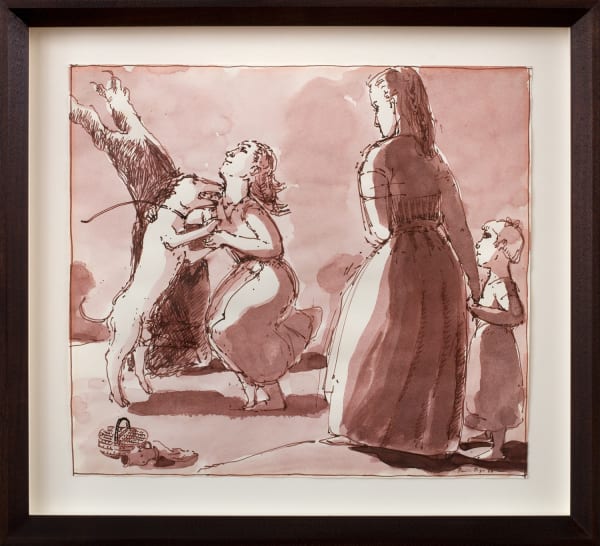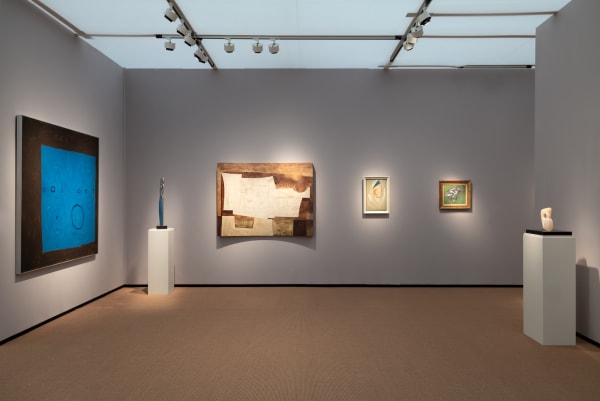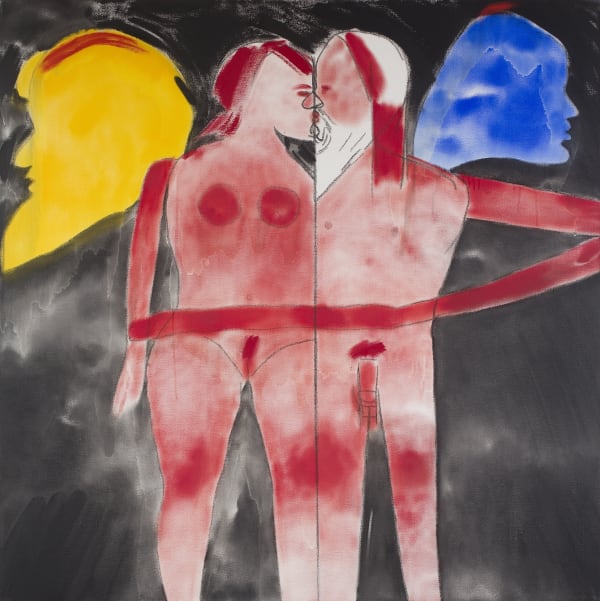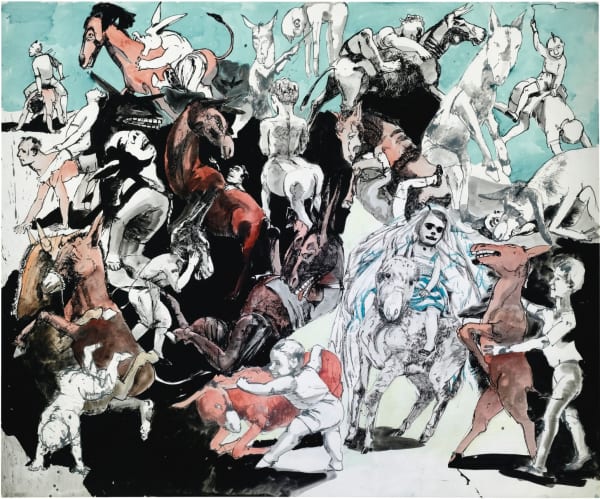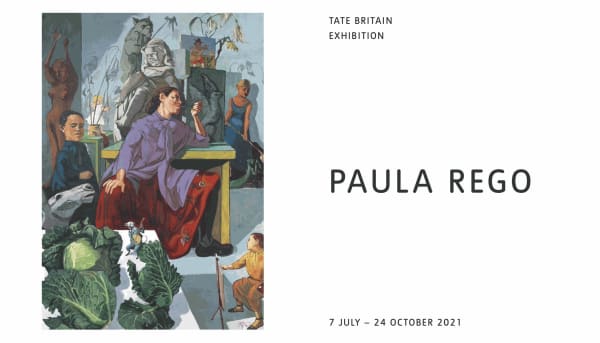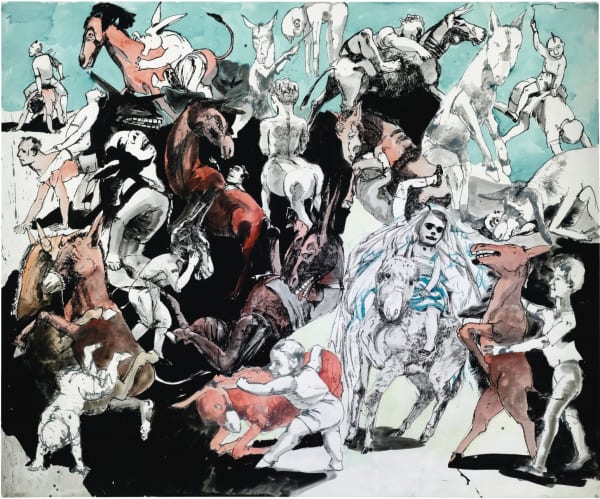Paula Rego
The gallery regularly handles, acquires and advises on works by Paula Rego. For more information or the availability of work, please contact the gallery.
Paula Rego (1935–2022)
Portuguese-born British painter and printmaker. Her parents were Anglophiles and sent her to London, where she studied at the Slade School, 1952–6. It was at the Slade that she met her husband, the painter Victor Willing (1928–88). They lived in Portugal from 1957 to 1963, divided their time between the two countries from 1963 to 1975, then settled in London.
A Dubuffet exhibition in London in 1960 made a strong impact on Rego, encouraging a freeing of the imagination. Subsequently she made considerable use of collage, frequently cutting up her own drawings as raw material. While her paintings of the 1960s appear abstract, there is an element of figuration deriving from the mechanistic humanoids of Duchamp and Ernst. The Firemen of Alijo (1966, Tate) was inspired by the sight of firemen in traditional Portuguese coats, huddled together during an exceptionally cold winter. There are also fighting angels in the picture, derived from medieval art. Her paintings have frequently referred to her Portuguese background under the dictatorship of Salazar—a socially privileged environment, but one which gave little scope for the advancement of women.
In a 1991 film she spoke of her distaste for a situation in which wealthy women were admired for how little they did while poor women had to cope with terrible burdens and this is reflected in much of her work. Sometimes the relationship between the genders is portrayed with extraordinary brutality, as in the series dating from 1981 about the red monkey and his wife, in which toy animals enact a cruel saga of domestic violence and betrayal on both sides. These paintings still had a graffiti-like quality which reflected Dubuffet's influence, but her best-known works are closer to Magic Realism. These again centre on the role of women in society. In some, women engage in domestic tasks—the plucking of a goose, the polishing of a policeman's boot—but seem to hold some sly secret. The most poignant of this series is The Family (1988, Saatchi collection): a prone, perhaps lifeless male on a bed is attended to by his wife and daughter who appear to be attempting some kind of revival while a smaller girl prays by a window. The work was made at a time when Willing was dying of multiple sclerosis, which had severely debilitated him for several years. Rego herself has suggested that it be thought of as a Resurrection subject. The religious symbolism, however, is cryptic. In the background a toy theatre has a figure of St Michael slaying the dragon.
From the 1990s onwards Rego's large-scale works tended to be made in pastel. In spite of living in London she has continued to be pre-occupied with Portuguese society. One series of works attacks that country's anti-abortion laws. Rego has also made etchings, including a series based on the case of the ‘Pendle witches’, hanged for witchcraft in the early 17th century. She once said: ‘I get inspiration from things that have nothing to do with painting: caricature, items from newspapers, sights in the streets, proverbs, nursery rhymes, children's games and songs, nightmares, desires, terrors.’
She is one of the most widely admired painters working in Britain today and her preoccupation with women's experience has made her work of special interest to feminist critics such as Germaine Greer (Rego's 1995 portrait of her was commissioned by the National Portrait Gallery), and Marina Warner (b. 1946). In 1990 she was appointed the first Associate Artist of the National Gallery, London. She painted murals in the restaurant of the gallery's new Sainsbury Wing in 1991, and in 1992 she became the first living artist to be given an exhibition in the gallery.
Text Source: A Dictionary of Contemporary and Modern Art
-

Frieze Masters
Regents Park, London 15 - 19 Oct 2025 Art FairPiano Nobile exhibited at Frieze Masters with a curated display illustrating key episodes in British art of the last century. Highlights included a significant alabaster sculpture by Barbara Hepworth, works...Read more -

Masterpiece
Royal Hospital Chelsea 30 Jun - 6 Jul 2022 Art FairPiano Nobile exhibited at Masterpiece Art Fair in 2022, then London's leading art and antiques fair. Highlights from the gallery's stand included significant works by Walter Sickert, Henry Moore, Paul...Read more -

Drawn to Paper
Degas to Rego 24 Jun - 24 Jul 2020In 2020 Piano Nobile presented Drawn to Paper: Degas to Rego , an online exhibition which showcased works on paper by some of the leading figures of European modernism. The...Read more
-

InSight No. 175
Paula Rego | Girl Exposing her Throat to a Dog July 12, 2025Paula Rego used pictures to tell stories. Sometimes they presented a version of her own life. Other times they illustrated fairytales or her own fantastic...Read more -

Museum Exhibition Loans
Exhibitions we are supporting this summer May 15, 2024Piano Nobile is delighted to be lending works for a selection of major museum exhibitions this summer. Charleston in Lewes , Matthew Smith: Through the...Read more -

Outstanding Exhibit
Masterpiece 2022 June 29, 2022Paula Rego, Island of the Lights from Pinocchio, 1996 awarded outstanding exhibit at Masterpiece Art Fair Island of the Lights from Pinocchio draws together images...Read more -

Paula Rego now on show at Tate Britain
Paula Rego, Tate Britain July 7, 2021Piano Nobile are delighted to loan Island of the Lights from Pinocchio to the UK's largest and most comprehensive retrospective of Paula Rego's work to...Read more -

InSight No. 30
Paula Rego | Island of the Lights from Pinocchio July 31, 2020Growing up in Portugal in the 1940s, Paula Rego was awed by the technicolour riches and prancing creatures of one Disney film after another. It...Read more





